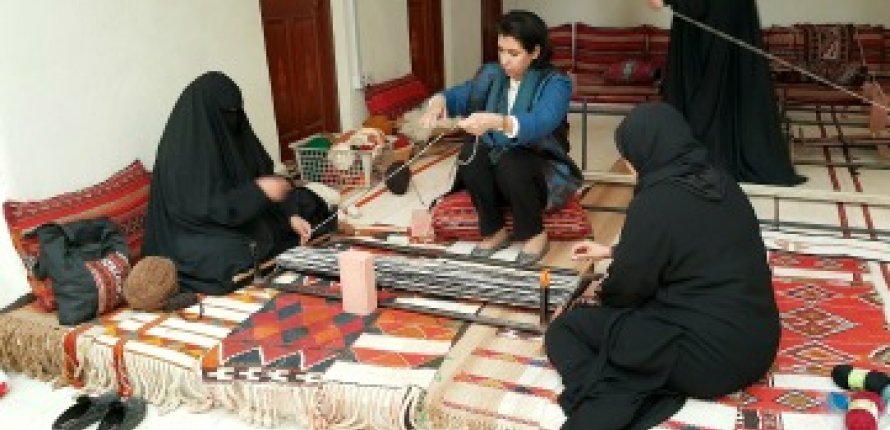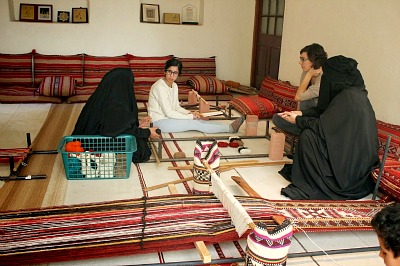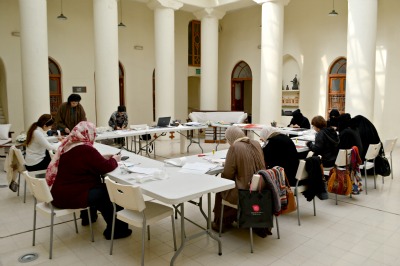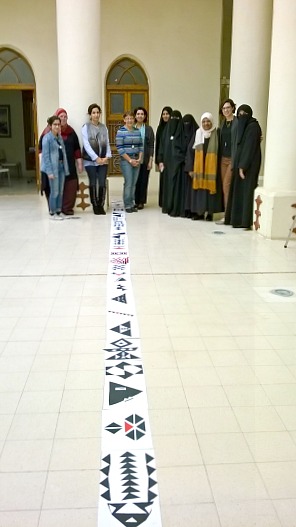Weave Around the World

Lesli Robertson, Senior Lecturer at the University of North Texas
January 2015 Fulbright Specialist to Kuwait
In January 2015, I first set foot in Kuwait to work at the Al Sadu House as a Fulbright Specialist. This was my first trip to the Middle East and my first hands-on experience with Bedouin textiles. As an artist, my practice focuses on engaging with diverse communities to develop ways to highlight the value of textile-based art forms. I fell in love with textiles over 15 years ago when I first started my graduate work. My love came from the knowledge that throughout the world, there are countless cultures whose use of textiles is deeply rooted in their history and their sense of identity. I was very eager to serve as a Fulbright Specialist with the Al Sadu House because I would be able to discover for myself the value of Sadu weaving. Through many conversations with the U.S. Embassy in Kuwait, and Lisa Heilbronn who I worked with in Uganda in 2008, we decided the purpose of my visit would be two-fold: to give a lecture on engaging in community-based artwork in conjunction with the Qurain Festival and lead a workshop on innovations in woven designs at Al Sadu House.
 Lesli Robertson with weavers, Muteria and Laila, and
Lesli Robertson with weavers, Muteria and Laila, andSarah Alfarhan, an awesome artist and wonderful translator!
My challenge throughout this Fulbright experience was to identify what I would be able to give back to Al Sadu House and the talented weavers I would be working with. This was truly the challenge, because, really, who am I to teach weavers who could weave me under the table?! My knowledge of Sadu weaving coming into this project was pitiful, if I am to be honest. I gleaned what information I could from several blog posts and websites and then went through my collection of world textiles books to find any references I could. My limited prep time did not allow me to order the specific books on Sadu written by very capable and talented art historians, so I came needing to learn.
When I first stepped into the Al Sadu House, I was overwhelmed by seeing textiles that I had only experienced in books. The size and scale of the work, the intricacy of the patterns, and the craftsmanship of each piece showed the strength of this traditional art form. Over the next several days, I had the honor of having two of the Sadu weavers, Muteria and Laila, introduce me to the art of Sadu weaving. We were able to set up the smaller version of their horizontal ground loom. Thankfully, this is very similar to most looms around the world, so I had some familiarity with it. As I sat and worked, or rather struggled, with the process of weaving with sheep and camel fibers, I was able to hear more from each weaver about their work and their experience with Sadu. This art form is one that is passed from generation to generation, depending on the next to carry it forward. Laila and Muteria weave in traditional ways, but continue to work towards finding new innovations in design and technique. New symbols and products are being thought of that reflect their current society. Each weaver has individual approaches to their work and ideas to grow it. They are not only incredibly talented weavers, but eager and innovative designers.
 Workshop Designing for Innovation
Workshop Designing for Innovation
These conversations, as well as others with the historian and patron of Al Sadu house, Sheikha Altaf Al-Sabah, heavily influenced the development of the workshop I held the next week. Many times, traditional textiles are filed in the category of craft while other media have the association with art or fine art. My thought for the workshop was to look at Sadu weaving within the context of art and design. My prompt for the workshop was: Can we take the elements and principles of design and apply these to the tradition of Sadu weaving? By teaching art as it relates to this traditional textile, can the weavers themselves be the developers of innovative works of art and design?
We titled the workshop Designing for Innovation, and it was planned to be truly collaborative. I had the opportunity to work with a wonderful group of women devoted to the Al Sadu House, who were energetic and eager to explore new interpretations of Sadu symbols and objects. We spent five days designing and envisioning new approaches these textiles. As an artist, I made sure that I stepped back, allowing my role to be focused on leading the process of designing, not creating the designs myself. Dozens of designs were produced by the participants as a result of the collective energy, thought, and talent of these women. As Al Sadu House works towards putting these designs into production, I know that the energy each participant brought to the workshop will propel these new innovations in design forward. (Currently, they are under wraps until Al Sadu House launches them as a collection). I feel that the workshop reached the goals we all had envisioned: learning about art and design in relation to Sadu weaving; developing innovations with Sadu; and finally, teaching myself out of the job, so that these new approaches could continue once I left. After only five, three-hour workshop days (only 15 hours) I was amazed at what we were able to accomplish.
 One of our accomplishments from the workshop.
One of our accomplishments from the workshop.
Al Sadu House recognizes that the value of Sadu cloth comes from the weavers; their passion, ideas, and creativity continues to allow the weavings to be a part of the present, not just the past. They also know that it is vital to continue to educate the community about the process of weaving, the women who weave, and the value of preserving this art form. When I gave my lecture on community art during my first week in Kuwait, I spoke about the value of engaging the community in the development of artwork and how that creates a new collective voice. I discovered so many voices in this workshop that were interested in the conversations surrounding the value of this cloth, its relationship to contemporary art and design, and how to engage more members of the community in discovering it for themselves. Because of these conversations, I am continuing to work with Al Sadu House and several partners in Kuwait to create an interactive community artwork focused on Sadu weaving. We are still in the initial phase of development, but this is an incredible opportunity to think abou
t how to further the goals of Al Sadu House by promoting and educating the community about the value of Sadu.
This Fulbright grant was a first for me in many ways: it was the first workshop I led that was bilingual, both English and Arabic. The amazing Sarah Alfarhan did an incredible job translating everything from complex design ideas to one-on-one conversations, and basically anything that was said, from English into Arabic. It was also held in such an amazing and inspiring place, the courtyard area of Beit Al Sadu (Al Sadu House), built in 1936. The architecture, detailing of each room, and the history of the place was such a unique experience to be in day after day. From these very first experiences, I have to say that the Fulbright Specialist Program is amazing. I have been able to be challenged as an artist, educator, and person in countless ways. The value of this program is that innovation is fostered through the ability to connect to organizations and people across the world, share knowledge, exchange ideas, and see what the collaborations will yield.
Check out more of Ms. Robertson’s work on the U.S. Embassy in Kuwait Facebook page and her blog Weave Around the World.
